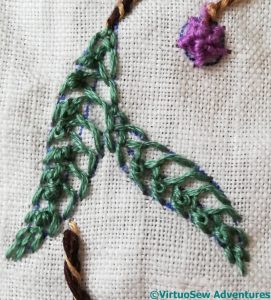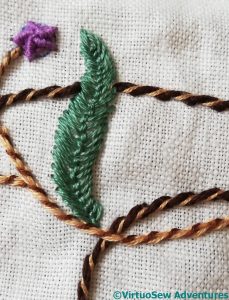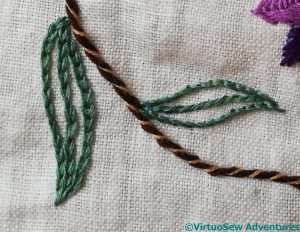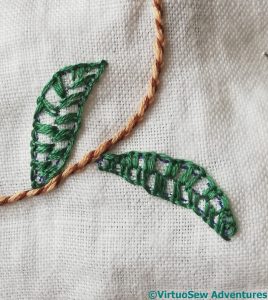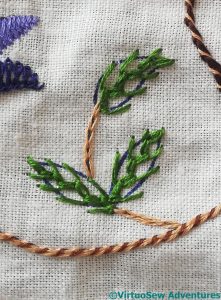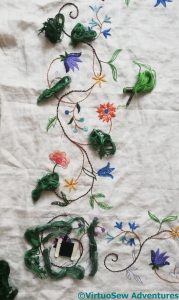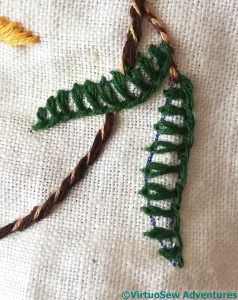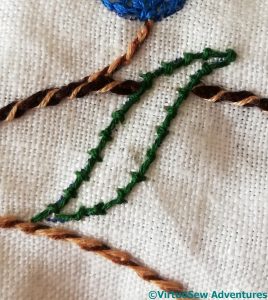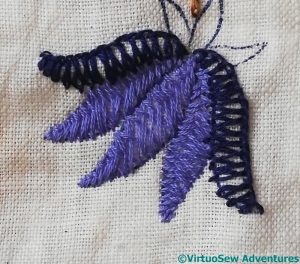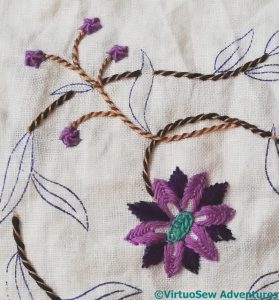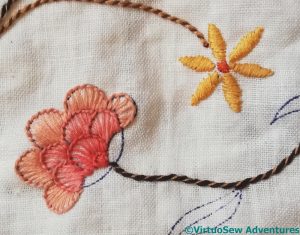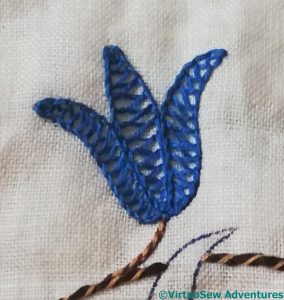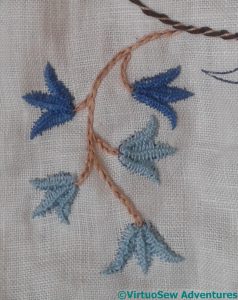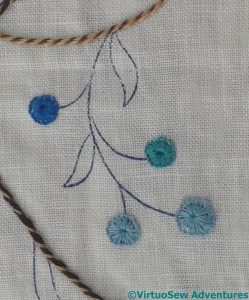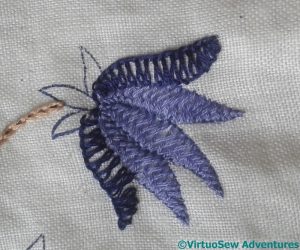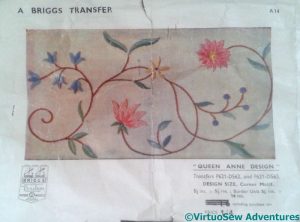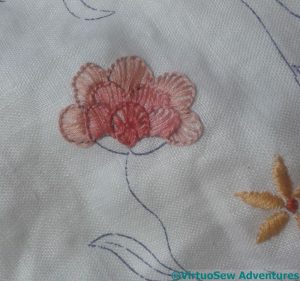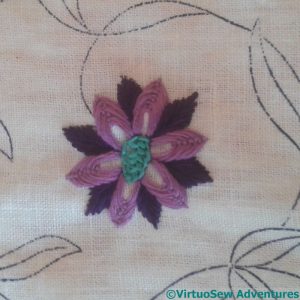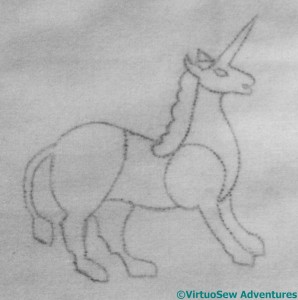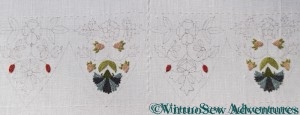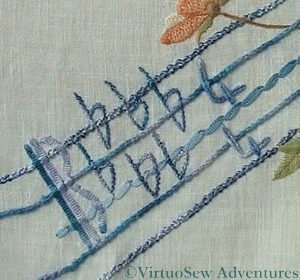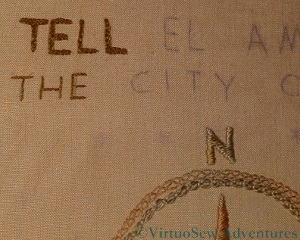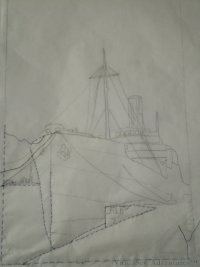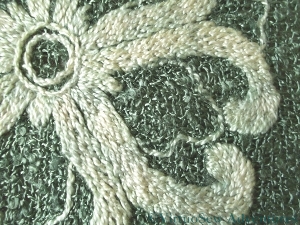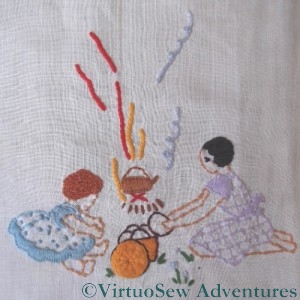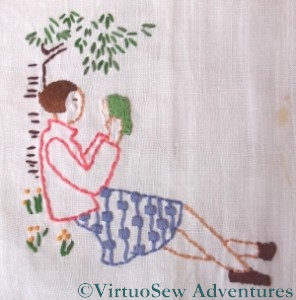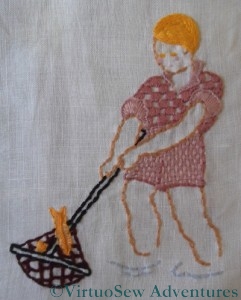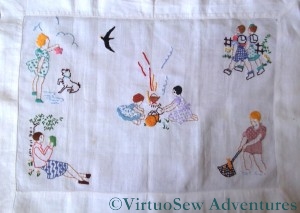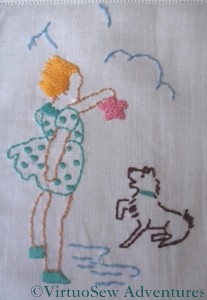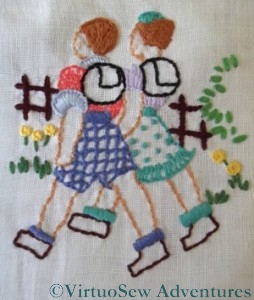Tag: transfers
Still more progress on the tablecloth
It’s arguable that I’ve created a sampler rather than a tablecloth, but as I’ve got closer to finishing it and laid it on the floor to look for any missing bits, it’s looking cheerful, and that is really all I ask of it.
Mountmellick Thorn Stitch is an old friend, strongly textured but contained. It’s not entirely straightforward to shape it to the leaf shape of the design, but I think it works rather well!
Nested Fly Stitch is another old friend, although one I’m not on such good terms with as some others. In the dim and distant past I worked two 2-foot high trees in Nested Fly Stitch (on the Persian Fantasy Screen) and they drove me nearly demented! However, it does create a solid coverage that isn’t fishbone stitch or satin stitch, and I wanted to make sure that the various leaves varied in coverage and tone. This is the “Heavy” end of the scale!
And this is the “Light” end of the scale – just outlines, in stem or chain stitch. These flow beautifully around curves, of course, and are really good for organic shapes, but I do need to remind myself that I don’t have to use obscure stitches all the time, and I’m allowed to choose the obvious ones occasionally!
The next episode – Episode Seventeen – of SlowTVStitchery is now up, and concerns mainly the little girls and some planning of Nefertiti..
More progress on the tablecloth
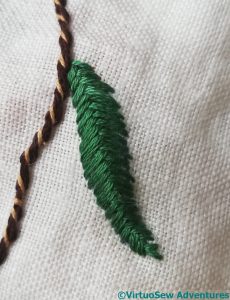
Each time I decide how to do a particular element, I do all four appearances. I decided on this very early on, because I knew that working a whole side and then copying it three times would drive me absolutely mad!
Raised fishbone stitch creates a nicely embossed effect, providing a good contrast with all the open stitches I’ve used. It requires a bit of concentration – this is a little raggier than I’d like – but at this point, I want the wretched tablecloth done, so I’m likely to just move on..
I’ve been looking at other embroidery styles of late – one can’t be wallowing in gold all the time, and one of these days I will be able to think of doing something else – and I’ve been reminded of just how effective groupings of blanket stitch or buttonhole stitch can be. This is the simplest variant I could think of, but I must remember that simple stitches like blanket stitch offer endless possibilities for variation..
One of the attractions of surface embroidery is the possibility for stitches to evolve themselves into being. I’m calling this one “Feathered Zig Zag Chain Stitch”. I can’t believe I’ve invented it, but neither can I remember having seen it before, and I think it works rather well. It certainly flowed familiarly off the needle, like an old friend.
The photograph has reminded me, however, that I need to finish whipping my chain stitch stems!
And new in SlowTVStitchery, Episode Thirteen is now up. In which, at long last, a Decision is made….
Progress on a project long in abeyance
You may recall this tablecloth, which I won in a job lot of things in an auction on eBay, a long time ago. I regarded it as my “traveling project” for a while, but didn’t travel much, or when I got there, found I couldn’t settle to it, and it’s been lingering and hanging over my head rather. It may well be that the current situation will give me the opportunity to get it finished. It will make a change from the details of the Amarna Family Group!
So, since I’d forgotten what I’d planned (or if I’d planned!), I laid it out on the floor and played around with skeins of cotton, to see what I could come up with.
The way I’ve worked on the tablecloth is that as I’ve what to do with each motif, I’ve worked each instance, and that way the whole tablecloth advances at once.
The Basque Stitch of these leaves is rather more spaced out than in the previous appearance of that stitch in the tablecloth – spacing, as well as scale, plays a part in altering the appearance and emphasis of a stitch.
Coral Stitch is nice and simple. Such a nice rest…
Yes, I know the concept of or nué is simple, but the execution isn’t, believe me!
And, speaking of or nué, Episode 12 of SlowTVStitchery is up! Do go and have a quiet half hour with me…
State of the Tablecloth – 2
I like Basque Stitch – it has a family resemblance to blanket stitch, and recalls chain stitch as well, so it’s a good stitch to pull together a piece that includes both.
The inner petals are closed herringbone stitch. I’m determined to nail this stitch one of these days, but this is not that day. It was a constant battle, and it looks a bit raggy.
Although not raggy enough for me to unpick it!
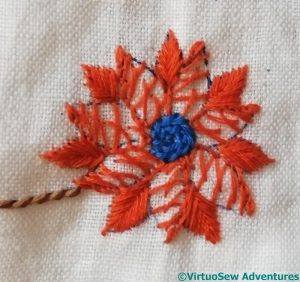
I unpicked and tried several variations for this one, and I’m still not sure of it.
The centre is a spiral of stem stitch, and the blue is the one from the tulip in the previous post.
The outer petals are in fishbone stitch, and the inner petals are in another blanket stitch variation. I think I may have got this one from one of Edith John’s books, and I’m pretty sure it will look much better once the transfer has been washed off. If not, I may have to re-stitch yet again!
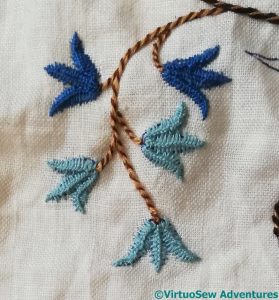
I think I suggested these might be harebells, or something similar. They are worked in Vandyke stitch, and although they do create a strong effect, it may be a bit busy.
Whatever else it is, this will be a wildly colourful tablecloth!
State of the Tablecloth – 1
That transfer I’ve been working on wants to be finished, and I’m pretty much at the stage of thinking about the leaves, so just so we all know where it’s up to, I’m doing a State of the Tablecloth post.
So the petals of the purple flower are in nested fly stitches, the centre is a sort of looping interlace, and the little buds are spider’s wheels. I packed the spider’s wheels quite tightly, to raise them up and increase the texture – I know that raised elements on a tablecloth can be a problem, but it’s no problem on the falling part!
The small starflower is the only element that I’ve done as the instructions that came with the tablecloth suggested – satin stitch.
The ruffly flower – do you think it might be a crysanthemum? – seemed a perfect opportunity for buttonhole stitch fans. I might decide to whip the edges to pull out the colour progression a bit more, but we’ll see what the flower wants when the leaves are on.
Double chain stitch is easily confused with closed feather stitch, and in this case I complicated my life considerably because I changed the breadth of the stitch to match the petals of the flower. I rather like the effect, and although I said it was a complication, the actual stitching flowed quite nicely.
And rather than give you a Long Read, look out for episode 2…
Current Travelling Project – Transfer Tablecloth
You may recall that I started on a tablecloth using a Briggs Transfer, as my “travelling project“. I’ve not travelled much, so progress has been somewhat spotty, but when the weather turned very warm while I was playing with my embellisher, I set the wool aside to pick up the tablecloth.
I suppose these might be harebells or bluebells or something similar?
I’ve worked them in Vandyke Stitch, which creates a strong central rib on each petal. It can be a tricky stitch to get just right, because tension makes a huge difference, and I may have worked them a little too tightly.
I’ve also changed each of the four appearances of this figure – there are two colours, and the disposition of those two colours isn’t quite the same in any two. It made it more interesting to stitch!
The next set of sprigs was this design element, and for this I went very old school and traditional – buttonhole wheels!
Furthermore, I used the same idea as with the harebells (if that’s what they are). This time, three colours. The one nearest the stem always dark, the furthest from the stem always light, the other two different on each of the sides of the tablecloth.
These two sprigs went swiftly. One heatwave, and they were done.
This blueish-purple flower won’t be so quick. The inner petals are in closed herringbone stitch. I’m getting better at that, but it is a time consuming stitch and I sometimes tie myself in knots still.
The outer petals are in Basque Stitch, another one that I sometimes tangle. It’s pretty, and creates an intriguing effect. I’ve worked both petals from the base to the time, which produced a few odd contortions. But when it works, I think it’s lovely!
It’s also one of my 17 UFos for 2017 – see Meredithe’s post for more!
Something Simple(-ish)
The Azorean Cutwork was not a very successful travelling project, as it needed to be precise, and the poor light of the average hotel-room made precision difficult.
I think this tea-cloth came from the same lady responsible for my fragment of the Quaker Tapestry, and the extra embroidery frames I knew I hadn’t bought. The instructions suggest a welter of unlikely colours and an excess of satin stitch, and I was nearly weak enough for follow them.
Then my mother pointed out that I’ve just done a single-stitch project, and should maybe cut loose a bit.
No sooner suggested than taken up! The wild colours are staying, but the stitchery will be a little more diverse…
After doing yellow satin stitch daisies with orange centres, I used blanket stitch fans for the next flower. I’m sure I’ve seen this before, or used it before, but I can’t remember where!
The design is composed of four corner designs and four straight sections which are all the same. I’m working each bit as I decide on it, rather than working one whole side and then copying it three times. That means that the puzzling and decision making is alternating with the stitching, rather than an orgy of decisions followed by the tedium of doing the same thing over and over and over again.
The purple flower is part of the corner motif, and alternates fishbone stitch (the dark petals) with nested fly stitches. The centre is a circle of blanket stitches with some random interlacing to fill them in.
Transferring Designs
Any book on embroidery will usually tell you about methods for transferring designs to the fabric. In fact, I think some of them are guilty of plagiarism – although from whom, in the best traditions of the circular firing squad, it would be hard to know.
Last week there was a discussion on Twitter relating to the Great Lady’s Magazine Stitch Off and particularly concerned with transferring the design once you’d chosen it, and I suddenly realised that not one of my shelf (ahem, shelves!) of embroidery books actually suggested which method might be most appropriate when, or what hazards or difficulties they present.
So I thought I would pull together what I’ve picked up and found out over the years…
First, Prick and Pounce. This is one of the oldest methods – almost certainly the only one available to the Lady’s Magazine subscribers. I’ve come to it relatively recently, but I use it a lot. It’s not good when my tennis elbow flares up, because pricking holes in the pattern is a slow and repetitive business, perfectly designed to produce a repetitive strain injury. It’s also not good – as I discovered with the pashmina for the Stitch Off – with a mobile fabric which is a little widely sett for the thickness of the constituent yarns. I had to reinstate the lines with a dressmaker’s chalk, which wasn’t nearly as precise as I would have liked!
Next, the Light Box method. Actually, not having a light box, it’s a “tape it to the window and do your best” method. I did this with the Gentleman’s Glittering Nightcap, and it worked fairly well, but it’s limited to the size of your window or lightbox, whereas Prick and Pounce is limited by the size of your table! I also become nervous when using indelible ink such as the (recommended and provided) Pigma pen. I’m always terrified of inadvertently drawing a line somewhere I can’t cover it.
Which leads me on to a caution. I’ve used quilter’s “disappearing” felt pens instead in the past, and had one of the scariest embroidery experiences I’ve ever had. First of all, the lines didn’t last quite long enough for a hand stitcher, and then…
When I washed the piece, the lines reappeared, and what’s more, they kept coming back. I can’t remember what it took to be rid of them, but certainly some prolonged soaking in detergent was involved.
Hair-raising doesn’t begin to describe it, and as mine is nearly a yard long, that’s no joke!
I used a Transfer Pencil for the Map of Amarna. This works nicely – provided you remember to reverse the pattern if it needs it! – if the fabric is a natural fibre. However, it can be hard to keep the transfer clean as you make it, and then there is a risk that you will transfer indelible smudges to the fabric.
I’ve also found that the lines sometimes spread as they transfer, which may or may not be a problem, depending on how detailed the design, and how much unembroidered fabric may be showing. As it always says on the packaging – test the whole process on your fabric before using it for anything important!
In the case of a really tricky fabric, such as the velvet for the Camberwell Panel, Running Stitch through tissue paper works really well. It’s rather time consuming, but then, I don’t think any method is especially swift.
There are soluble fabrics which I know many stitchers recommend, but I’ve only worked one piece using it, and the design drawn on the soluble film was hard to see, so I can’t describe it as an unalloyed success.
In truth, a stable natural fabric such as linen will probably happily accept anything thing you do, and the fragile, “difficult” ones will each require a different response. The trick is to remember to pause before starting, to make sure you pick a sensible method for the fabric and the design!
Holiday Traycloth – second installment
Now this is very “Swallows and Amazons“, isn’t it!
There’s a woven spiders web wheel for the top of the picnic basket, the little girl’s red hair is worked in coral stitch and her older sister’s is satin stitch. It’s barely visible in the photo, but the satin stitch is angled this way and that to create something that looks a little like a Marcel wave – a very grown up style on a relatively young girl!
As in the first installment, the cuffs and flounces are in blanket stitch. The spots are French knots, and the lilac dress is worked as a pattern of back stitches.
This motif, “Reading” shows particularly clearly how skilled the designer was in making the best possible use of simple shapes and simple line. Much of the design uses straight stitches – for the leaves, the bark, and the stems of the leaves.
The pattern on the skirt alternates back stitches with tiny satin stitch blocks, and the hair is stem stitch. The book and the shoes are satin stitch, the flowers are French Knots, and anything else is in back stitch.
It couldn’t be simpler to do, but doesn’t it look good!
This is the point where – after nobly containing my experimental impulses for quite some time! – I indulged in a few wanderings from the path laid down. The shorts are actually woven! It must have been tricky to get right, but it’s worked really well – they look slightly tweedy, but in any case the sort of heavy fabric that any sensible mother would clothe her child in for scrambling around rocks and beaches.
The little gold fish is worked in Vandyke stitch, which is tricky to keep even but creates a strong line down the side of the fish to contrast with the net in the background.
Holiday Traycloth – first installment
I worked this immediately after the First Voluntary Project, and my goodness, is there a difference between the two! I think I must have talked with Grandmama and looked at some of her embroidery, and it looks as though suddenly the whole idea “clicked”.
The motifs are from transfers from another of Grandmama’s Needlewoman Magazines (August 1934, if you are interested!), worked on an old piece of linen in stranded cottons. The design was suggested to be a cover for a photograph album, but since my family isn’t really photograph-conscious, I felt that such a thing would be superfluous, and finished it as a traycloth instead. We added the seagull to cover a hole in the linen, which was already quite old.
The range of stitches is very limited on this piece – I must have been following the instructions in the magazine – and the whole thing is surprisingly neatly worked. I love the little girl’s spotty dress (satin stitch spots!) and windswept stem stitch hair, and the starfish is wonderfully knobbly, with closely packed French knots.
Most of the outlining across the whole piece is in back stitch, and although I didn’t count it precisely, I suspect the weave of the linen made that much easier to do than it might have been.
The designs themselves are very reminiscent of the children’s books of the period – it’s even exactly the right sort of dog, slightly scruffy, but always ready to play!
These walkers have blanket stitch collars and cuffs, and stem stitch hair. His shorts are worked in Jacobean Couching and the spots on her skirt are French knots. The leaves on the bush in the background are detached chain, and the yellow flowers are blanket stitch wheels. Again, the hair is in stem stitch and the socks (like the little girl’s shoes) are in satin stitch.
You’ll notice that all of these stitches re-occur when I describe the other motifs, too. The designer has made absolutely first-class use of all the stitches.

